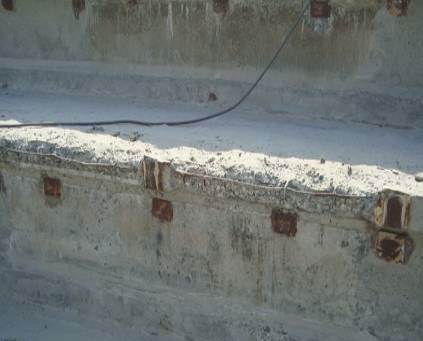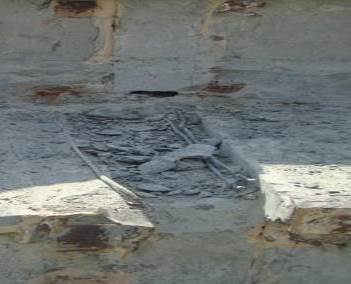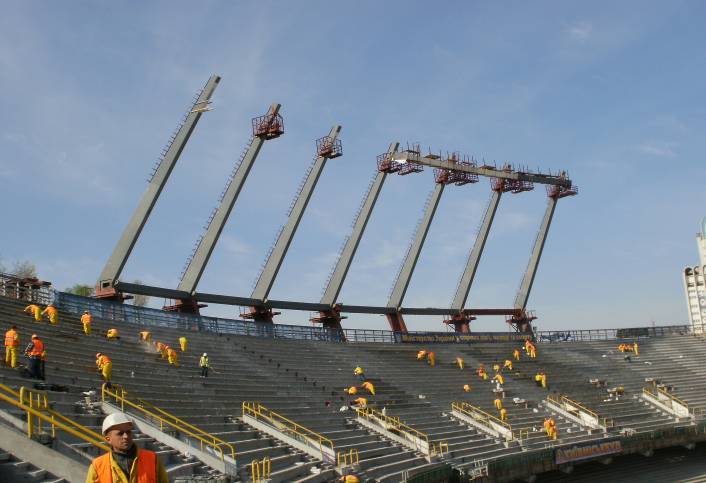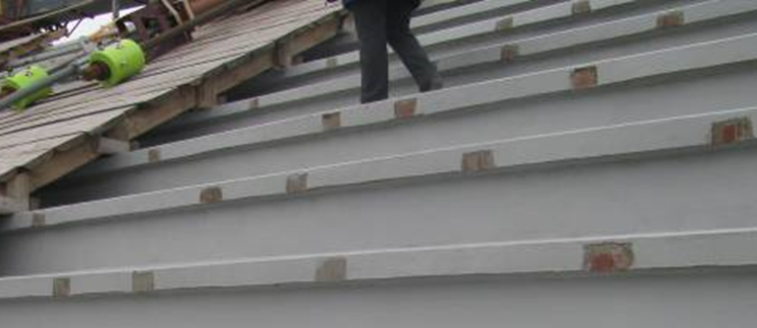Savyovsky Vololymyr V., Bronevitsky Andrei P., Savyovsky Artem V.
Quality Assurance of Renovated Concrete Constructions
Savyovsky Vololymyr V.
doctor of technical sciences, professor
Kiev National University of Civil Engineering and Architecture
31,Povitroflotsky Avenue, Kiev-037, 03680 Ukraine
Bronevitsky Andrei P.
candidate of technical sciences, associate professor
Institute for Innovative Education of
Kiev National University of Civil Engineering and Architecture
31,Povitroflotsky Avenue, Kiev-037, 03680 Ukraine
Savyovsky Artem V. candidate of technical sciences
Research Institute of Construction Industry, Kiev, Ukraine
Abstract
The article deals with some aspects of reconstruction of damaged reinforced concrete constructions, implementing advanced materials and technologies. The importance of adherence to building regulations ensuring workmanship quality is emphasized.
Keywords: repair of reinforced concrete constructions, building regulations, repair aggregates, workmanship
Under the process of overhaul or alteration works resetting building construction features service is executed. Renovation involves repair or strengthening of structures. There are best known practices for the specified works accumulated in the construction area. Many structure strengthening methods have become the standards[1]. Works on reinforced concrete constructions strengthening have obtained wide spread occurrence. There are several strengthening methods differentiated by their types, designation and technical condition such as structural section enlargement, changing construction behavior and installation of additional supporting parts. For the above mentioned work types flow diagrams are developed and are detailed in various scientific and technical publications. However, practices in engineering diagnostics of constructions show that constructions repaired previously lose their serviceability[2] in the process of time. Analysis of construction damages and deformations demonstrates that sources of failures are in violation of building regulations that had been issued before repair and restoration works were executed.Wherefore researches in the area of provision of careful adherence to work execution processes are the critical mission for academic construction engineers.
For the analysis of the indicated problem there is a good reason to consider the example of repair and restoration works execution while under reconstruction of the National Sports Complex “Olimpiysky” in Kiev. Works were performed prior to the 14th European Football Championship 2012 (UEFA Euro 2012).
Due to continuous exploitation cohesion strength of the specified constructions ranged from 0.5 to 3 MPa, salinity level on some sites was high and compression capacity was 15- 50 MPа. Cavities, spalls and pots including ones with reinforcement exposures within folding panels were detected. During the panels inspection significant surface damages of folding panels used for upper circle of stadium stands were found. Damages were represented by concrete cover liftings, reinforcement exposures and partial damages of concrete, Fig.1. Cohesion strength of the specified constructions ranged from 0.5 to 3 MPa and compression capacity ranged from 15 to 50 MPa.Lifting of covers that have been provided on repair and reconstruction purposes were detected. It was found that the preceding repairs of folding panel coverings had been executing in 1966-1991 period. Cement-sand, concrete and bituminous concrete surfaces as well as epoxy and polyurethane paint coatings were used for repair. Encrustation thickness was 30 mm.


Fig.1. Reinforced concrete construction damages of folding panels after cutting off encrustation from concrete repair mortars
Based on the results of conducted diagnosis the author of this publication proposed execution of folding panel construction renovation using the advanced produced domestically aggregates as a solution. It was considered to demolish damaged construction coverings at first with the following reconstruction using the advanced materials. Experts from Scientific Research Institute of Building Constructions (SPIBC) and Scientific Research Institute of Construction Manufacturing (SRIBM) were also involved in development and approval of decisions on construction renovation. System of repair materials CERESIT PCC produced by “Henkel Bautechnik” (Ukraine) was agreed for usage. This system contains such key products as mineral single-component and rust-preventing filler Ceresit CD 302012, which is also used for contact (adhesional) layer covering and polymer cement coarse-grained aggregate for repair and restoration.
Ceresit СD 222012, used for repair of local damages with a depth ranged from 30 to 100 mm as well as polymer cement filler Ceresit CD 242012 used for concrete surfaces background with the thickness up to 5 mm.In addition to key products system also includes protecting and strengthening compositions, among them:Thomsit R 766 - multifunctional acrylic primer coat; Ceresit CС 832012 – elastic emulsion used as additive for enhancing their elasticity;Ceresit СF 87 – epoxy primer coat for concrete and reinforced concrete foundations;CeresitСF91 –polyurethane coating for moderate loadings; Ceresit СF 97 – decorative and protective polyurethane paint.Key criteria when selecting concrete repair and restoration system Ceresit PCC:
- types of loads (РСС І, РСС ІІ, РСС ІІІ);
- compatibility by technical parameters of structure basis and materials of restoration system (elasticity modulus, temperature line expansion coefficient etc.);
- system resistance to the environmental impact effect;
- conditions of use (temperature, humidity, surface preparation, accessibility etc.).
In addition, there were requirements for polymer cement repairing materials on ensuring adhesion with old concrete of at least 2 MPa, compression capacity of at least 20 MPa after 48 hours and 40 MPa after 28 days as well as freeze-thaw resistance of not less than 200 cycles. The main requirements for decorative and protective polymer covering materials were: tear strength of 5.5-6 MPa, adhesion to the foundation of at least 2.5 MPa and weathering resistance of not less than 25 conventional years.
Works on folding panel reconstruction were executed in the following technological order. At the first stage there was a pre-construction with relative repaired structure divisioning and creation of safe and lean working conditions, Fig.2. Then, the following operations were executed: concrete surfaces shaping with diamond face milling cutters, beating with kango hammer damaged concrete from out the folding panel overhangs on the horizontal surfaces of folding panels (till the depth will reach no less than 20 MPa where strong concrete is located),dedusting the surface using industrial vacuum cleaners and reinforcement cleaning using wire brushes till St2 preparation grade as well as reconnection of bar reinforcement of reinforcing steel net using tying wire. After repair and restoration of folding panel overhangs of reinforced concrete constructions with the necessary exposed and already cleaned reinforcing bars covering with anticorrosive aggregate and with subsequent panel geometry reconstruction through filling polymer cement aggregate for repair into a non-prefabricated form were executed.According to the preliminary specifications repair and restoration works were followed by laying as creed on the horizontal panel surface containing presizing operations, covering adhesional layer with alkali-resistant grid reinforcement, laying as creed using coarse-grained aggregate for repair on the surfaces. Vertical surfaces of folding panels were repaired (in the absence of considerable damages) using polymer-cement spackle with a layer thickness up to 5 mm.
Decorative and protective finishing of folding panels using epoxy and polyurethane materials was executed after repair material for the screed was reaching the required strength.Moreover, all processes were executed according to the regulatory technological order with strict observance of the technological breaks specified in the Flow Diagram [3]. General information on the reconstruction process for the specified structures can be found in Table1.Appropriate quality control was provided on the each stage.

Fig.2. Relative workzone divisioning for repaired structures
Order represented in Table 1 and well-defined materials allowed to execute works on the proper quality level. After repair and restoration works had been finished folding panels obtained design condition, Fig.3. The important work execution element is quality control reflection in the operating construction documents [4,5]. Additionally to promotion of workers discipline in supporting an appropriate quality level of works, this also helps in skill development and obtaining experience during work execution.

Fig.3. Folding panel appearance after finishing repair and restoration works
Works were executed by worker team including 2 concreteres, 2 pargeters, 2 sandblasterers and 2 builder's handymen within each workzone. General work labour input was 912.33 man hours on 100 m2of repaired surface.
The executed work scope for the above given example presented that workmanship can be achieved by strict adherence to the following:
1. Project on Works Execution (PWE) with accurate instructions regarding technology and work organization should be developed before works will be started;
2. Studying by all workers the building regulations specified in the PWE and Flow Diagram regarding execution of works and irreversible following their instructions;
3. Pre-installation inspection on availability compliance and quality of building materials;
4. Pre-installation inspection, process control and acceptance inspection on quality of work execution with mandatory records in the executive documentation (closing concealed works form, works log).
Literature
1. Savyovsky V. V. Technology of construction and repair of constructions: manual / V. V. Savyovsky. - Kh.: Lider publishing house, 2014.-256 pages.
2. Savyovsky V. V. Technology of reconstruction. - Kh.: Basis, 1997.-256 pages.
3. SBS А.3.1-5-2009 Organizational of building production-K.:MinRegionBuild of Ukraine, 2011.-60p
4. Karapuzov E.K, Soha V. G, Laykin V. V, Ayzman P. B. Standard flow charts on restoration and protection of concrete and ferroconcrete designs of transport construction with use of systems of materials of the Ceresit trademark (Ceresit System). – K.: HighEducation, 2010. - 152 pages.
5. Production schedules of works on repair and restoration of foalding panels, columns and beams of the top circle National Sports Complex “Olimpiysky / DP ND_BK. MET-315-781.09-005, 2009.
